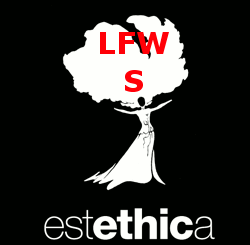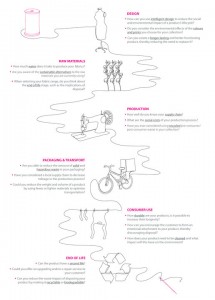 Yesterday: Day 4 – Off-track: Quietly sustainable brands.
Yesterday: Day 4 – Off-track: Quietly sustainable brands.
Next: Paris Ethical Fashion Show September 2010: D-1 – Slow Fashion DIY
There are a number of things in relation to sustainability and fashion, the two as a combination as much as individually, that caught me fairly off guard. I think it is worth to spend some more thoughts on this, and since such insights are at the same time a retrospection, I shamelessly this trail of thought as ‘my’ personal LFW Fall 2010 summary.
It was a bit of a surprise on my account that the vast majority of brands don’t seemed to have spent a minute asking themselves why they exist, who they really are, and why to buy them rather than anyone else’s products. For many it is plainly about, quiet selfishly, ‘making beautiful things while not having to bother with the the rest’.
In fact, there is very little grounded knowledge about what consumers actually are looking for (did any one think of something as practical as the laundry of garments?), what their likes and dislikes are, and why they would want to by a brand. No, it’s all about ‘I like doing this, and somehow I will find people to pay for this’ even though the world really doesn’t need yet another jewelery, military, or knitwear brand.
Also, I perceived a severe lack of vision. Hardly any exhibitor at LFW seemed to have an idea where they, or their brand, would want to be in 5, 10, 20 years time. A characteristic of our times? Maybe. But certainly also the consequence of an industry that lives through 2 seasons each year, only to try yet again to grab the headlines of a magazine that will be in the recycle bin in a week’s time. Not that there were any good reasons to produce 2 collections a year in first place.
Note: And it’s probably besides the point to mention that this year’s 2010/11 collections looked fairly identical to its predecessor, as well as the predecessor’s predecessor. Novelty and innovation is NOT what the fashion industry and its designers are currently strong at it seems.

This all said, from the many conversations I had with exhibitors, designers, assistants and brand marketing representatives, it feels that sustainable brands are in their make-up inherently different from non-sustainable brands. What IS a sustainable brand is a question that remains despite EstEthica and all the media frenzy about the sustainable catwalk. So, without having come to a final conclusion – here a summary of the insights I gained from the many a conversation I had.
- Sustainability in fashion has a lot to do with awareness of who your are and where you come from as a brand.
Good brands know where their stuff comes from, how it is being produced, shipped and sold. This does not necessarily mean that by knowing the process in your brand’s supply all is good. But it is a statement about the importance the brand and its products have for you. - A sustainability commitment in a fashion brand, possibly more than in any other industry, is a loud commitment to be in for the long haul.
Sustainability in this sense, is a business strategy that clearly aims at establishing the brand and the company behind it, to leave a lasting legacy. It is a strategy that looks much farther ahead than just to the point in time when profits can be skimmed off, without any other legacy than the amount of cash in the bank account or the quantity of fabric occupying space on the rubbish pit.
Every single business decision, hence, is considered deeply and carefully from the beginning. Time and efforts is invested to carefully outline and define the details of a brand; from the product range and design decisions, over sourcing, to the production process, and the manufacturing site. The key players within the company feel strongly accountable for what they do, how their products come into being, and whom they are sold to. Equally strong is the transparency practised: not all may be perfect, but crucially, none of it is a mystery or a secret. Problems and challenges are being pointed out, and so is what is being done about them and why.
In the end, the story behind the product is consistent and honest. - Brands that practice sustainability, are 1) aware that power distances (‘pyramid of power’) in the industry do exist, and 2) set up so as to make them as flat as reasonable achievable, and manage the power distance overall well.
Power distances do exists, and probably always will, even under the best of all fairtrade conditions. Workers are getting paid by the factory, the factory by the buyer, the buyer by the retailer and, in the end, the retailer by the customers. An important part of sustainable brands is that they manage this pyramid of powers well, and make it as flat as reasonable achievable. - Sustainable brands have recognised that customers have a chief influence on the business, and make this insight work in favour of them.
The concept though, holds true for any commercial brand competing for customers. Only what gets bought (ordered) is being produced, hence designed. The more consumers actually do decided to go sustainable themselves – and to indeed walk the talk – the more retailers will have no other choice than to cater to them, and as a consequence this consumer pressure will cascade down the whole supply chain right to its roots.
Hence, sustainable brands create a need at the grassroots level for their type of products, and motivate the consumers to carry this newly found requirement of theirs into other [competing] brands. - Brands that consider themselves sustainable, are are in one way or another, always involved with their community.
Good staff relations and determination to across the whole company to deliver high quality products are a given. More importantly this related to quality is not pursued ‘over the workers’ head’, but rather in close collaboration with them.
It also mean that local traditions are being cherished. Be in through ‘made in the UK’, or through collaborations with fairtrade co-operatives, or by integrating local crafts and design knowledge into the design and production of an item – the local link is firmly embedded in how the company behind a brand functions. - DESIGN IS KEY (and yes! in capital letters).
Design is what makes people pay a few hundred pounds for a hand bag, rather than a couple of tenners.
It is hence design that will be decisive in having consumers choose an ethical brand over the overly cheap p* brand. Only when buying at the P* becomes a synonym to bad taste, then the battle will on its way to a final showdown.
Sustainable fashion needs the best-of-the-best designers. When ethical becomes equivalent with being creme-de-la-creme in design and looking good, THEN finally the stigmas will be a chapter of the past.
THEN fashion will have become an industry that finally can be proud of itself.
Next: Paris Ethical Fashion Show September 2010: D-1 – Slow Fashion DIY
Yesterday: Day 4 – Off-track: Quietly sustainable brands.

